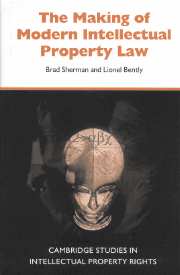Book contents
- Frontmatter
- Contents
- Acknowledgments
- List of abbreviations
- Table of statutes and bills
- Table of cases
- Introduction
- Part 1 Towards a property in intangibles
- Part 2 The emergence of modern intellectual property law
- Part 3 Towards an intellectual property law
- Part 4 Transformations in intellectual property law
- Bibliography
- Index
2 - The mentality of intangible property
Published online by Cambridge University Press: 29 May 2025
- Frontmatter
- Contents
- Acknowledgments
- List of abbreviations
- Table of statutes and bills
- Table of cases
- Introduction
- Part 1 Towards a property in intangibles
- Part 2 The emergence of modern intellectual property law
- Part 3 Towards an intellectual property law
- Part 4 Transformations in intellectual property law
- Bibliography
- Index
Summary
If we open any present-day textbook on intellectual property law, one of the first things we notice about intangible property is that it is usually spoken of as and associated with objects or things. Moreover the subject matter of intellectual property law is usually thought of by intellectual property lawyers as being non-creative, unitary and closed. Typically, the tendency to think of the intangible in this fashion is not confined to contemporary intellectual property law, but is also at work when the subject is viewed historically. If we suspend our modern preoccupation with the intangible as a non-creative, closed object and let pre-modern law speak for itself, a different and somewhat perplexing picture of intangible property begins to emerge. It is our aim in this chapter to explore the nature of the intangible as it reveals itself in pre-modern intellectual property law. We will begin to do this by showing that one of the overriding concerns of pre-modern intellectual property law was with creativity. Indeed it could be argued that creativity was, at least in certain guises, the primary focus of the law. In turn, we argue that to understand the way in which law grants property status to the intangible, it is necessary to appreciate that the legal conception of intangible property embodies a number of conflicting demands that pull the law in different directions. Importantly while creativity may have been displaced with the move from pre-modern to modern law, many of the tensions which coexist within the legal notion of intangible property continue to play an important role in shaping present-day law.
Creativity and intellectual property law
Although it was not until the early part of the nineteenth century that the language of creativity was used with any degree of consistency, the common denominator which united patent law, literary property and indeed all areas of law which granted property rights in mental labour was a shared concern with creativity. While in the eighteenth century most of the discussions concerning mental (or creative) labour focused on literary property, the concern with creativity extended far beyond this to include all forms of intellectual property then in existence.
Information
- Type
- Chapter
- Information
- The Making of Modern Intellectual Property LawThe British Experience, 1760-1911, pp. 43 - 60Publisher: Cambridge University PressPrint publication year: 1999
